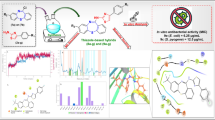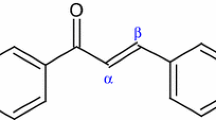Abstract
Herein, a series of lasiokaurin derivatives were designed and synthesized. All the derivatives together with lasiokaurin and oridonin were tested for their antimicrobial and antiproliferative activity. Compound 16 showed the most promising antimicrobial activity with MICs of 2.0 and 1.0 μg/mL against Gram-Positive bacteria S. aureus and B. subtilis, respectively. All the synthetic lasiokaurin derivatives showed better antiproliferative activity than parent compound lasiokaurin 1. Compound 10 exhibited the strongest cytotoxicity with IC50 values of 0.47 and 0.20 μM against MGC-803 and CaEs-17 cells, accordingly. Moreover, it was shown to have potent antitumor activity in vivo in a murine model of MGC-803 gastric cancer. Preliminary SARs were also concluded based on obtained data. The apoptosis-inducing effects of 10 were further investigated using CaEs-17 cells. The results showed that lasiokaurin derivative 10 could induce apoptosis via mitochondria related pathway and arrest CaEs-17 cell cycle at S phase. Compound 10 could also affect apoptosis-related proteins that was up-regulation of CDK2 and down-regulation of ATM and cyclin A1.







Similar content being viewed by others
References
Bahadori MB, Valizadeh H, Asghari B, Dinparast L, Farimani MM, Bahadori S (2015) Chemical composition and antimicrobial, cytotoxicity, antioxidant and enzyme inhibitory activities of Salvia spinosa L. J Funct Foods 18:727–736
Camarillo JM, Rose KL, Galligan JJ, Xu S, Marnett LJ (2016) Covalent modification of CDK2 by 4-hydroxynonenal as a mechanism of inhibition of cell cycle progression. Chem Res Toxicol 29:323–332
Degorce SL, Barlaam B, Cadogan E, Dishington A, Ducray R, Glossop SC, Hassall LA, Lach F, Lau A, McGuire TM, Nowak T, Ouvry G, Pike KG, Thomason AG (2016) Discovery of novel 3-quinoline carboxamides as potent, selective, and orally bioavailable inhibitors of ataxia telangiectasia mutated (ATM) kinase. J Med Chem 59:6281–6292
Ding C, Zhang Y, Chen H, Wild C, Wang T, White MA, Shen Q, Zhou J (2013a) Overcoming synthetic challenges of oridonin A-ring structural diversification: regio- and stereoselective installation of azides and 1,2,3-triazoles at the C-1, C-2, or C-3 position. Org Lett 15:3718–3721
Ding C, Zhang Y, Chen H, Yang Z, Wild C, Chu L, Liu H, Shen Q, Zhou J (2013b) Novel nitrogen-enriched oridonin analogues with thiazole-fused A-ring: protecting group-free synthesis, enhanced anticancer profile, and improved aqueous solubility. J Med Chem 56:5048–5058
Ding C, Zhang Y, Chen H, Yang Z, Wild C, Ye N, Ester CD, Xiong A, White MA, Shen Q, Zhou J (2013c) Oridonin ring A-based diverse constructions of enone functionality: identification of novel dienone analogues effective for highly aggressive breast cancer by inducing apoptosis. J Med Chem 56:8814–8825
Ding C, Wang L, Chen H, Wild C, Ye N, Ding Y, Wang T, White MA, Shen Q, Zhou J (2014) ent-Kaurane-based regio- and stereoselective inverse electron demand hetero-Diels-Alder reactions: synthesis of dihydropyran-fused diterpenoids. Org Biomol Chem 12:8442–8452
Ding Y, Ding C, Ye N, Liu Z, Wold EA, Chen H, Wild C, Shen Q, Zhou J (2016) Discovery and development of natural product oridonin-inspired anticancer agents. Eur J Med Chem 122:102–117
Fujita E, Nagao Y, Node M, Kaneko K, Nakazawa S, Kuroda H (1976) Antitumor activity of the Isodon diterpenoids: structural requirements for the activity. Experientia 32:203–206
Gurkan-Alp AS, Göker H, Alp M, Ozkan T, Sunguroglu A (2015) Synthesis and anticancer effects of some novel 2-(4-phenoxyphenyl)-1H-benzimidazole derivatives on K562 cell line. Arch Pharmacal Res 38:650–658
Kao YL, Kuo YM, Lee YR, Yang SF, Chen WR, Lee HJ (2015) Apple polyphenol induces cell apoptosis, cell cycle arrest at G2/M phase, and mitotic catastrophe in human bladder transitional carcinoma cells. J Funct Foods 14:384–394
Lepiarczyk M, Kałuża Z, Bielawska A, Czarnomysy R, Gornowicz A, Bielawski K (2015) Cytotoxic activity of octahydropyrazin[2,1-a:5,4-a′]diisoquinoline derivatives in human breast cancer cells. Arch Pharmacal Res 38:628–641
Li CY, Wang EQ, Cheng Y, Bao JK (2011) Oridonin: an active diterpenoid targeting cell cycle arrest, apoptotic and autophagic pathways for cancer therapeutics. Int J Biochem Cell Biol 43:701–704
Li D, Wang L, Cai H, Zhang Y, Xu J (2012) Synthesis and biological evaluation of novel furozan-based nitric oxide-releasing derivatives of oridonin as potential anti-tumor agents. Molecules 17:7556–7568
Li D, Cai H, Jiang B, Liu G, Wang Y, Wang L, Yao H, Wu X, Sun Y, Xu J (2013a) Synthesis of spirolactone-type diterpenoid derivatives from kaurene-type oridonin with improved antiproliferative effects and their apoptosis-inducing activity in human hepatoma Bel-7402 cells. Eur J Med Chem 59:322–328
Li D, Xu S, Cai H, Pei L, Zhang H, Wang L, Yao H, Wu X, Jiang J, Sun Y, Xu J (2013b) Enmein-type diterpenoid analogs from natural kaurene-type oridonin: synthesis and their antitumor biological evaluation. Eur J Med Chem 64:215–221
Li D, Xu S, Cai H, Pei L, Wang L, Wu X, Yao H, Jiang J, Sun Y, Xu J (2013c) Library construction and biological evaluation of enmein-type diterpenoid analogues as potential anticancer agents. ChemMedChem 8:812–818
Li D, Han T, Liao J, Hu X, Xu S, Tian K, Gu X, Cheng K, Li Z, Hua H, Xu J (2016a) Oridonin, a promising ent-kaurane diterpenoid lead compound. Int J Mol Sci 17:1395
Li D, Han T, Tian K, Tang S, Xu S, Hu X, Wang L, Li Z, Hua H, Xu J (2016b) Novel nitric oxide-releasing spirolactone-type diterpenoid derivatives with in vitro synergistic anticancer activity as apoptosis inducer. Bioorg Med Chem Lett 18:4741–4744
Li D, Hu X, Han T, Xu S, Zhou T, Wang Z, Cheng K, Li Z, Hua H, Xiao W, Xu J (2016c) Synthesis, biological activity, and apoptotic properties of NO-donor/enmein-type ent-kauranoid hybrids. Int J Mol Sci 17:747
Liao J, Yang F, Zhang L, Chai X, Zhao Q, Yu S, Zou Y, Meng Q, Wu Q (2015) Synthesis and biological evaluation of novel fluconazole analogues bearing 1,3,4-oxadiazole moiety as potent antifungal agents. Arch Pharmacal Res 38:470–479
Liu Z, Ouyang L, Peng H, Zhang WZ (2012) Oridonin: targeting programmed cell death pathways as an anti-tumour agent. Cell Prolif 45:499–507
Lovejoy CA, Cortez D (2009) Common mechanisms of PIKK regulation. DNA Repair 8:1004–1008
Min J, Guo K, Suryadevara PK, Zhu F, Holbrook G, Chen Y, Feau C, Young BM, Lemoff A, Connelly MC, Kastan MB, Guy RK (2016) Optimization of a novel series of ataxia-telangiectasia mutated kinase inhibitors as potential radiosensitizing agents. J Med Chem 59:559–577
Qiao A, Wang Y, Xiang L, Zhang Z, He X (2015) Novel triterpenoids isolated from hawthorn berries functioned as antioxidant and antiproliferative activities. J Funct Foods 13:308–313
Shen J, Zhang D, Zhao Z, Jia L, Zheng D, Liu G, Hao L, Zhang Q, Tian X, Li C, Guo H (2013) Synthesis, characterization, in vitro and in vivo evaluation of PEGylated oridonin conjugates. Int J Pharm 456:80–86
Shi M, Ren X, Wang X, Wang H, Liu G, Yuan X, Zheng S, Yu L, Pan S, Song G, Guo Q, Li L, Zhang X, Zhang Z, Ding H, Jiang G (2016) A novel combination of oridonin and valproic acid in enhancement of apoptosis induction of HL-60 leukemia cells. Int J Oncol 48:734–746
Wang L, Li D, Xu S, Cai H, Yao H, Zhang Y, Jiang J, Xu J (2012) The conversion of oridonin to spirolactone-type or enmein-type diterpenoid: synthesis and biological evaluation of ent-6,7-seco-oridonin derivatives as novel potential anticancer agents. Eur J Med Chem 52:242–250
Wang C, Wu P, Shi JF, Jiang ZH, Wei XY (2015) Synthesis and cancer cell growth inhibitory activity of icaritin derivatives. Eur J Med Chem 100:139–150
Xu J, Yang J, Ran Q, Wang L, Liu J, Wang Z, Wu X, Hua W, Yuan S, Zhang L, Shen M, Ding Y (2008) Bioorg Med Chem Lett 18:4741–4744
Xu S, Li D, Pei L, Yao H, Wang C, Cai H, Yao H, Wu X, Xu J (2014a) Design, synthesis and antimycobacterial activity evaluation of natural oridonin derivatives. Bioorg Med Chem Lett 24:2811–2814
Xu S, Pei L, Li D, Yao H, Cai H, Yao H, Wu X, Xu J (2014b) Synthesis and antimycobacterial evaluation of natural oridonin and its enmein-type derivatives. Fitoterapia 99:300–306
Xu S, Pei L, Wang C, Zhang YK, Li D, Yao H, Wu X, Chen ZS, Sun Y, Xu J (2014c) Novel hybrids of natural oridonin-bearing nitrogen mustards as potential anticancer drug candidates. ACS Med Chem Lett 5:797–802
Xu S, Luo S, Yao H, Cai H, Miao X, Wu F, Yang DH, Wu X, Xie W, Yao H, Chen ZS, Xu J (2016) Probing the anticancer action of oridonin with fluorescent analogues: visualizing subcellular localization to mitochondria. J Med Chem 59:5022–5034
Yan X, Yu Y, Ji P, He H, Qiao C (2015) Antitumor activity of endoperoxide-iron chelator conjugates-design, synthesis and biological evaluation. Eur J Med Chem 102:180–187
Yi Y, Yang G, Zhang C, Chen J, Liang J, Shang R (2015) Synthesis and evaluation of novel pleuromutilin derivatives with a substituted pyrimidine moiety. Eur J Med Chem 101:179–184
Zhang M, Zhang Y, Lu W, Nan FJ (2011) Synthesis and revision of stereochemistry of rubescensin S. Org Biomol Chem 9:4436–4439
Zhang TT, Yang L, Jiang JG (2015) Tormentic acid in foods exerts anti-proliferation efficacy through inducing apoptosis and cell cycle arrest. J Funct Foods 19:575–583
Zhen YH, Wang L, Riaz H, Wu JB, Yuan YF, Han L, Wang YL, Zhao Y, Dan Y, Huo LJ (2014) Knockdown of CEBPβ by RNAi in porcine granulosa cells resulted in S phase cell cycle arrest and decreased progesterone and estradiol synthesis. J Steroid Biochem Mol Biol 143:90–98
Acknowledgements
This work was financially supported by the National Natural Science Foundation of China (81373280, 21502121), Project Funded by China Post Doctoral Science Foundation (2015M570258), Jiangsu Key Laboratory of New Drug Research and Clinical Pharmacy (KF-XY-201401) and Career Development Support Plan for Young and Middle-aged Teachers in Shenyang Pharmaceutical University.
Author information
Authors and Affiliations
Corresponding authors
Additional information
Da-hong Li and Ping Hu contributed equally to this study.
Rights and permissions
About this article
Cite this article
Li, Dh., Hu, P., Xu, St. et al. Lasiokaurin derivatives: synthesis, antimicrobial and antitumor biological evaluation, and apoptosis-inducing effects. Arch. Pharm. Res. 40, 796–806 (2017). https://doi.org/10.1007/s12272-016-0867-9
Received:
Accepted:
Published:
Issue Date:
DOI: https://doi.org/10.1007/s12272-016-0867-9




